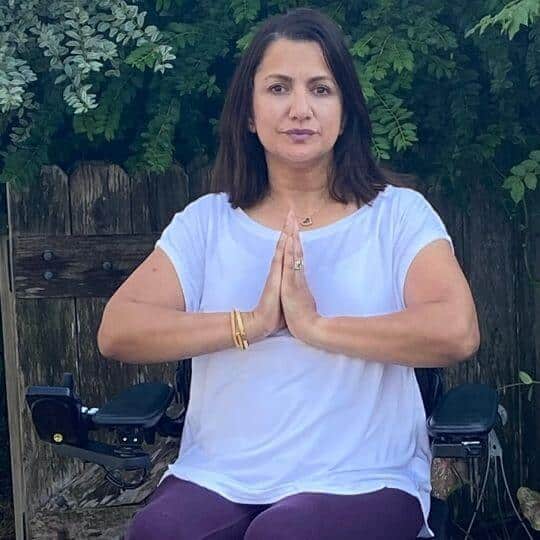Not only is September Spinal Cord Injury Awareness Month, but it is also Yoga Awareness Month too. As a woman living with a spinal cord injury, I have found that practicing yoga and meditation has been incredibly beneficial for me. Thanks to my experience in leading meditation class, I’ve seen firsthand how it can be beneficial for others too. So with my latest post, I’d like to talk about the benefits of adaptive yoga for those living with a spinal cord injury or other disabilities.

What is Adaptive Yoga?
Yoga is a practice that originated in India thousands of years ago. Today, it has become one of the most popular forms of exercise. It incorporates gentle physical movements and stretches with a focus on mindfulness and breathing. It can be a spiritual practice for some, while others prefer to practice yoga for their physical health.
Adaptive yoga is a way of making the practice of yoga more accessible to everyone, no matter their shape, mobility, weight, and energy level. This makes it perfect for people living with disabilities – even those of us in wheelchairs! Because so many variations of yoga exist, it’s easy to customize a routine to perfectly suit anyone, including people with physical limitations like paralyzation, chronic fatigue, muscle weakness, and more.
Personally, I have seen many benefits of practicing adaptive yoga along with meditation for the past 20 years since my spinal cord injury. I find that the aspect of mindfulness and meditation strengthens my mind. Plus, the basic stretching exercises are just as beneficial.
If you haven’t tried yoga or meditation yet, maybe my tips can help you decide whether you want to give it a shot. Of course, it’s always a good idea to talk to your doctor before starting out to see if practicing this type of exercise is a good option for you.
Top 3 Benefits of Adaptive Yoga
1. Improved mental health and reduced stress levels
Adaptive yoga, also known as accessible yoga, is a safe and supportive practice that incorporates gentle movements and poses with focused breathing.
Deep breathing may help decrease and regulate heart rate, lower blood pressure, and less muscle tension. This benefit can be especially helpful for those of us who live with trauma, such as the kind that can occur after a spinal cord injury, a stroke, or a diagnosis of chronic illness or disease.
In a recent study, researchers found that individuals with a spinal cord injury who began practicing yoga had some emotional and mental improvements. For example, they reported fewer incidents of depression as well as more self-compassion and mindfulness. Participants in this study saw these positive changes after only six weeks of twice-weekly yoga sessions.
2. Better physical well-being and flexibility
According to Yoga Journal magazine, practicing yoga can create physical benefits such as muscle strength, posture improvement, increased flexibility, and more. Some people also find decreased muscle spasms and less pain, while others feel that yoga has helped them regain a better posture and more strength in their mobile limbs.
Even if you live with paralyzation, as I do, you can still work out the parts that we cannot move by manually moving them ourselves. We can also do the same for the areas of the body that we can work out the parts that we cannot move by actually moving them ourselves, we can also do the same for the areas of the body that we can control. Stretching the arms and moving the torso all the way down to touch the toes while bringing the head all the way down is a great way to work out.
I find that the more I do these types of movements, the fewer spasms I have while sitting in my wheelchair. It is always a fantastic way to tone the muscles and lubricate the joints, ligaments, and tendons.
3. It can be practiced anywhere – even in your wheelchair.
Adaptive yoga can be done anywhere and by anyone of any motion level. You don’t have to force your body into hard poses, and you don’t have to be entirely able-bodied. Best of all, for those of us in wheelchairs, we can perform it easily while sitting. Additionally, yoga is easy to do, so even kids and seniors can do it.
I have made yoga part of my morning routine when I get dressed for the day. It’s very easy and doesn’t take much time. I spend about 10 minutes every day stretching out my legs. I concentrate on my ankles since they tend to get a bit too tight quite quickly. Just as I can stretch, pull myself forward or pull my shoulders back, I can also pick up one leg at a time and hug them.
I find these yoga exercises are especially helpful for the days I sit in my wheelchair longer than usual. You’ll find that the more you do these types of exercises, you increase flexibility while moving around in the wheelchair.
Helpful Resources for Adaptive Yoga
Do you want to get started on practicing adaptive yoga or wheelchair along with me and many others? Take a look at some of these helpful resources and videos to begin!
- Christopher & Dana Reeve Foundation Video Series: Adaptive Yoga Practice
- Your Own Gentle Approach: Adaptive Yoga Videos
- Yoga with Adriene: Gentle Chair Yoga Routine
- YogaJP: Mini Adaptive Chair Yoga Class for People in Wheelchairs
- Adapt to Perform: Wheelchair Yoga
- National MS Society: Yoga and MS